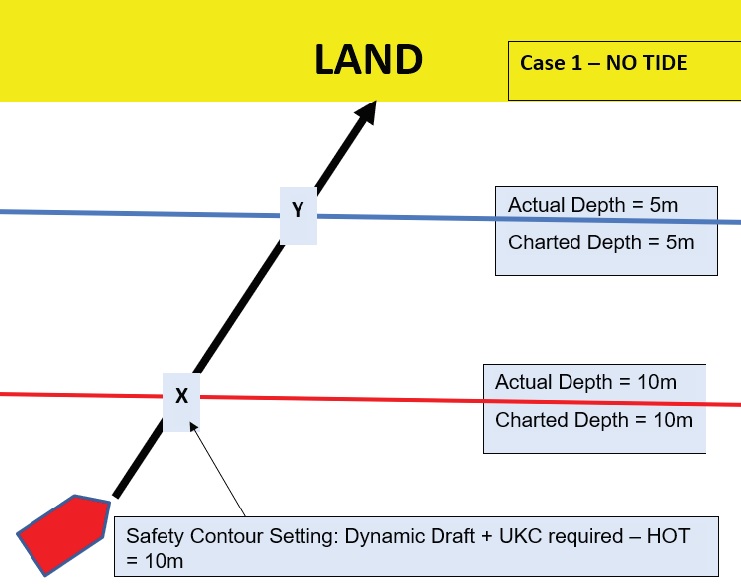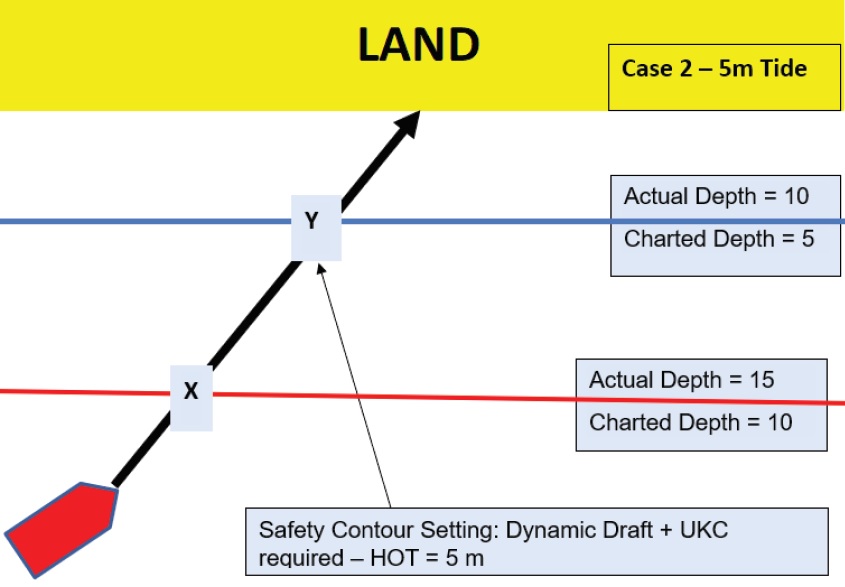Safety Contour = Dynamic draft + Minimum Net UKC requirement – Height of tide
Shallow Contour = One Contour less than Safety Contour
1. Why Height of Tide is being subtracted from the Safety Contour depth?
Why it is not added, as we do for depth calculation?
Let us use an example to understand this.

Say, there is a position “X” on ENC with charted depth of 10 meters. As we move towards shore, there is another position “Y” on ENC with charted depth of 5 meters.
Now, assume that, Vessel’s dynamic draft + Minimum UKC requirement add up to 10 meters.
OOW would like to receive an alarm when vessel reaches 10 meters’ depth so that he is warned that beyond this limit, navigational safety is at risk. OOW will set Safety Contour depth in ECDIS as 10 meters. When vessel reaches position “X”, ECDIS will provide an alarm to OOW and OOW will take required action.
This is visible in above Figure.
Now, let us consider the case, in which the tidal range in that area is 5 meters.Due to this tide of 5 meters, at high water, the actual depth in these positions will become:
Position “X” – 15 meters (Charted depth of 10m + 5 m tide)
Position “Y” – 10 meters (Charted depth of 5m + 5 m tide)
So, what should the safety contour depth setting in this case be?
If we are going to keep it the same as before (i.e., 10 meters without considering the height
of tide), OOW will get an alarm at position X (Charted depth -10 m) which is of no use.
This is shown in Below Figure . Because actual depth of water at “X” is now 15 meters.

That is why, we subtract the Height of tide to revise safety contour depth setting as 5 meters i.e. charted depth of 10 m – 5 m tide. The OOW will now get an alarm at position “Y”
(Charted depth of 5m, actual depth due to tide of 10 m).
OOW knows that Vessel is safe till position Y (of course, because of tide) and action is required to be taken when crossing position Y.
In a nutshell, OOW wants an alarm basis actual depth of water, while the ECDIS is to be set basis Charted depth. Hence, to get an alarm at any particular charted depth, OOW needs to subtract the height of tide.
If OOW does not subtract, the alarm will sound much earlier than needed, at 20 mts of actual depth (if we add the height of tide to the setting of safety contour setting, we will get the figure as 15 mts The actual depth at the location will be 15 (charted depth) + 5 (HOT) = 20 mts).
2. If height of tide is not subtracted, Vessel will get the alarm much in advance. What is the problem in erring on safer side?
Yes, you can say, there is no issue in erring on safer side. But then, your primary aim is to receive an alarm to remind you to act & not to ignore. The Safety Contour is one of the most critical safety alarms used in ECDIS. Once this alarm is muted and ignored, there is no more alarm to warn OOW regarding inadequate depth.
Hence, it is important to set the depth alarm in such a way that when Safety contour alarm sounds, OOW takes it seriously and knows it’s time to act. That is why, to make best use of this alarm, it should not be set to static draft of vessel. It should be adjusted with all dynamic factors such as tide, squat, etc. and to make the error as minimum as possible.
3. There will be areas with variable or unknown tide. How much tide to apply in that case?
Now that we know, height of tide is being subtracted to reduce the safety margin and make the safety contour depth as precise as possible.
However, there will be areas where OOW is not very sure about height of tide. Let us understand this with a similar situation as the previous example.
Say, Vessel is planning to call this port with tidal range between 3 to 5 meters. Hence, OOW’s first attempt should be to know the exact tide and subtract that value to get precise safety contour depth. If he is not sure of exact tide, he will go to one extreme and apply either 3 or 5 meters and get following as safety contour depth at position X:
i) If he applies highest tide of 5 meters, the safety contour depth at Position “X” will be set at 5 meters (Dynamic draft & net UKC requirement of 10m – HOT of 5 m tide)
ii) If he applies lowest tide of 3 meters, the safety contour depth at Position “X” will be set at 7 meters (Dynamic draft & net UKC requirement of 10m – HOT of 3 m tide)
Now, setting of Safety Contour of 7 meters by taking lower of the tidal range , vessel will get the alarm when actual depth is 10 metre even at the lowest tide (7 m + 3 m HOT) , whereas by setting contour of 5 m using higher of the tidal range, if, inadvertently, ship transits this area during low tide, she will only get an alarm at actual depth of 8 metre (5m + 3m HOT), by which time, she will already have run aground.
What this ultimately means is that even when there is an uncertainty of depth, you have assumed it on the side of safety.
OOW must keep in mind that subtracting tide is like eating up from safety margin. Hence, it should be applied but only if absolutely sure of.
In Open Sea, as it is, precision of safety contour depth is not that important, hence, better to use lowest astronomical tide of the voyage. In port approaches, precision is definitely required to make best use of this alarm. Hence, in coastal waters/ restricted waters, etc., proper tide calculation to be done for time of transit and same to be subtracted. However, if there is any confusion about the height of tide at a port and it is not possible to ascertain the actual height of tide during vessel’s transit through that area, then the lesser height of tide should be used for the calculation of safety contour.
4. Why is shallow contour marked as one contour less than safety contour? Will OOW to change more frequently?
Yes, there is no doubt that OOW will need to change the shallow contour depth setting in ECDIS as and when the contour interval changes.
But then, the shallow contour has been given separately in ECDIS from Safety contour for a purpose.
The concern is that whatever value we put, ECDIS takes nearest higher available contour in order to start showing the colour (to help identifying safe and unsafe depths at a glance) accordingly.
For example, if any ENC has contours at 5m, 10m, 15m depths, the Safety contour depth set at 8m, will automatically jump to 10m (Nearest higher value). If we set the shallow contour 7m or 6m, that will also jump to 10m.
So, in most of the cases, safety and shallow contour will overlap. Then what is the benefit of having a feature of shallow contour? That is why the best use of shallow contour should be made by always checking on ENC and setting it with value of one contour less than safety contour value.
In above example, OOW should manually set the value of shallow contour as 5m so that safety contour’s light blue colour shows at 10 m contour and shallow contour dark blue colour shows at 5 m contour on ENC.
If we leave shallow contour as Dynamic draft, the difference between Shallow and safety contour will mostly be so indistinguishable that both the contours will overlap with each other and will be of little practical benefit.
OOW should know that Shallow contour is a complete “NO Go Area”. OOW should plan action immediately after crossing safety contour and much before shallow contour. Reaching till shallow contour should mean Vessel is either aground or going to be running aground shortly.
The contour depth intervals on different ENC can be 2m, 5m, 10m, etc. Hence, OOW should see that and set the shallow contour depth value as one less than safety contour depth setting.
4 thoughts on “ECDIS Contour Setting depth”